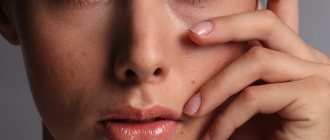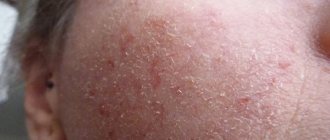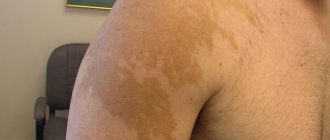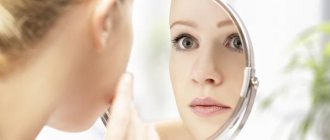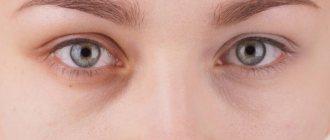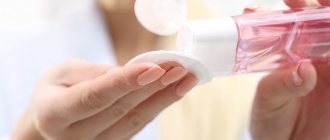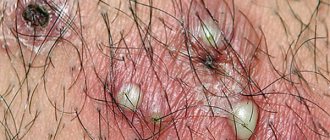Causes of redness
Red spots that appear on the face cannot be ignored, as they may indicate the development of serious diseases.
The reasons for their appearance are varied. In some people, the vessels are located close to the surface of the skin. Any physical or emotional stress causes a rush of blood to the face, causing it to turn red. Sometimes the problem appears as a result of exposure to ultraviolet radiation, wind or frost. In both cases, redness does not require treatment. There are also other reasons associated with poor lifestyle, bad habits, etc. Redness can be a symptom of some diseases. Most often this is an allergic reaction. It has several varieties:
- Respiratory - the problem appears in the spring, when there is a lot of fluff and pollen in the air, and is usually accompanied by symptoms of rhinitis.
- Contact – when an irritating factor comes into contact with the skin, it quickly turns red.
- Food – redness is a consequence of eating certain foods. If problems are ignored, skin itching, swelling and anaphylactic shock may occur.
Other causes of red cheeks include:
- fungal infections - cause irritation and unpleasant itching;
- various types of dermatitis;
- rosacea is a dangerous pathology manifested by redness and rash;
- vitamin deficiency - always accompanied by symptoms such as weakness and drowsiness;
- hormonal disbalance;
- cardiovascular diseases.
Sometimes red cheeks indicate the presence of serious problems - worms, lupus and even HIV infection, so it cannot be ignored.
Possible complications
Redness of the skin is observed with malar erythema. The cause of the appearance of a red rash in the cheekbone area can be hot weather, pregnancy, stressful situations, or the ovulation period. Photodermatitis, or sun allergy, also causes facial redness due to the skin's hypersensitivity to sun exposure.
Types of redness on the face:
- redness on the cheeks and bridge of the nose;
- spider-shaped blood vessels, especially in the cheeks and nose;
- rough red pimples accompanied by itching and tingling;
- thickened red skin around the nose, on the forehead.
Skin diseases cause hyperemia, which is accompanied by raised plaques, papules, peeling, and dryness. Some skin lesions, rosacea, acne dermatitis, are characterized by excessive redness.
Diseases that cause the face to turn red:
- Juvenile acne or acne. A disorder that occurs during puberty as a result of increased activity of the sebaceous glands. On sensitive skin, in addition to acne, redness, dryness, and irritation develop.
- Acne rosacea. A chronic skin disease that has cycles of relapse and remission. Occurs more often in women with white skin. It is characterized by redness in the central part of the face, purulent pimples, and increased skin temperature in the area of inflammation.
- Atopic dermatitis. An inflammatory disease of the skin not only of the face, but also of the body, accompanied by red papules, itching, and peeling.
- Cuperosis. When the disease occurs, blood circulation in the facial area is disrupted, causing damage to small capillary vessels that are located closer to the surface of the skin. The capillary pattern becomes clearer over time, and stripes of capillaries are visible. Associated symptoms are itching, tingling, burning. Over time, the vessels, expanding more and more, are unable to contract normally. The disease develops in stages. At stage 1, hyperemia occurs for no apparent reason, periodic sensations of “hot flashes” on the skin of the face. At stage 2, a clear picture of the vascular pattern is visible. During stage 3, the disturbance of local circulation becomes chronic, and the possibility of developing inflammatory reactions increases.
Redness on the face due to rosacea will progress to rhinophyma
Doctors associate the appearance of rosacea, the most common cause of redness, with taking hormonal contraceptives, replacement therapy for endocrine system disorders, and pregnancy. There is also a connection between the appearance of rosacea and diets, bad habits, and frequent consumption of coffee and chocolate.
Redness on the face, which can only be removed by curing the underlying disease, is often caused by infections, both systemic and local:
- Erythema infectiosum. The cause of the disease is parvovirus B19. The red rash on both cheeks has a clear pattern in the form of a slap mark. Simultaneously with the lesion on the face, the rash appears on the arms and legs. The disease rarely occurs in people with a healthy immune system.
- Scarlet fever. A red skin rash appears simultaneously with a sore throat. When the disease occurs, small red bumps appear on the skin, resembling sandpaper; the skin on the arms and legs is not affected. Another symptom is a bright red tongue.
- Streptococcal pharyngitis. Inflammation of the oral mucosa caused by infection. The disease is characterized by the appearance of a red rash.
Immune disorders affect the appearance of hyperemia in the facial area:
- Allergy. This may be a reaction to cold, and in addition to redness, dryness, peeling, and itching of the skin appear. The body's response to foods and plants manifests itself not only on the face, but also on the body and hands.
- Menopause. A decrease in the production of female sex hormones, estrogen and progesterone, affects the body of women. Menopause symptoms: facial flushing, frequent urination, insomnia, depression, can last for years depending on your health.
- Drug-induced and discoid lupus. In the dosage form, a red, butterfly-shaped erythema develops on the cheeks under the influence of long-term use of sulfonamides, antibiotics, and neuroleptics. With the discoid form, red scaly spots appear on the skin of the face, which can subsequently lead to atrophy of the facial skin.
- Cluster headaches. They occur in a series of attacks lasting no more than 15 minutes. Attacks may recur from several weeks to several months. Characteristic symptoms: flushing of the face, the appearance of tears, blockage of the nasal area, acute headache.
Endocrine disorders affect color changes:
- Hyperthyroidism. An active thyroid gland causes symptoms due to a high metabolic rate: high blood pressure, sweating, redness on the face, brittle hair, weight loss, menstrual irregularities. Frequent and severe facial redness in people with hyperthyroidism occurs in the summer.
- Cushing's syndrome. The disorder is caused by excess cortisol in the body. The typical manifestation is a round face with increased hyperemia, which is especially noticeable on the cheeks. Additional symptoms include acne, muscle weakness, high blood pressure.
Cardiovascular diseases and blood diseases affect changes in complexion:
- Mitral valve stenosis. When the valve lying between the left atrium and the ventricle narrows, blood accumulates in the vessels that carry it from the lungs and back. In addition to the red face, other symptoms occur: cough, sometimes with blood, shortness of breath, dizziness.
- High blood pressure. When the heart works faster, the blood vessels narrow and the muscles contract, which leads to increased blood pressure. One of the symptoms is facial redness, other signs: shortness of breath, puffiness, memory impairment, and vision.
- Aging, obesity. Processes that affect the state of the vascular system, changes in blood circulation.
Vitamins and medications can cause redness on the face. You can remove hyperemia by refusing to take them or reducing the dosage.
Drugs that affect color change:
- vitamin B3 and all supplements including cyamine;
- glucocorticoids;
- calcium channel blockers;
- cholinergic drugs;
- opiates;
- thyrotropin;
- cyclosporine;
- doxorubicin.
People dependent on steroid medications often complain of redness, severe itching, burning and rash not only on the face, but throughout the body. This is especially true for those who use acne medications and anabolic steroids.
Many causes of facial redness are not related to systemic diseases and do not threaten life or health. In many cases, they present aesthetic problems that can be resolved on your own or by following the advice of a doctor. If there are spider veins on the face, it is advisable to conduct an examination to exclude various pathologies.
In some cases, in order to stop the process of damage to the deep layers of the skin along with blood vessels, it is necessary to carry out a course of restorative treatment and skin nutrition in order to prevent premature aging and sagging of the skin.
If the redness on the face is not associated with an illness, then you can remove the redness yourself or in a beauty salon. But in any case, it is wiser to consult a dermatologist so as not to harm your skin.
Allergic diseases
Allergic diseases are a common cause of redness of the skin of the cheeks. In this case, it is important to promptly identify and eliminate the factor that provokes the development of the disease.
An allergist or dermatologist will help you competently cope with this task.
Allergic urticaria
Allergic urticaria
This is a disease of an allergic nature, characterized by the appearance of rashes on the skin of the face, torso, and limbs.
The cause of the development of allergic urticaria is exposure to various irritants on the body:
Allergic urticaria is characterized by a sudden onset. The rash appears in the form of bright pink or red blisters, spots of various shapes and sizes, prone to merging. The skin in the area of the rash is always very itchy. The cheeks have a bright scarlet color, the skin is somewhat swollen, due to which the face looks puffy.
The disease often occurs against a background of increased body temperature, deterioration in general health, and aching joints.
A life-threatening complication of allergic urticaria is Quincke's edema, in which swelling of the mucous membranes occurs. The most dangerous condition becomes when the process spreads to the larynx and bronchi, which can lead to difficulty breathing, asphyxia and, if medical assistance is not provided in time, to death.
Treatment for allergic urticaria includes the following medications::
It is necessary to follow a hypoallergenic diet.
Treatment of Quincke's edema is carried out in a hospital setting.
After treatment, the rashes disappear without a trace.
Allergic contact dermatitis
Allergic contact dermatitis
The disease occurs when the skin of the cheeks is exposed to irritants that are allergens for a particular person. These can include various cosmetic products (creams, masks, lotions, scrubs, makeup removers), as well as medicinal creams and ointments.
Redness appears on the skin of the cheeks in the form of pink or red spots, nodules, and microbubbles. Peeling and crusts are observed on the surface of the rash.
In allergic contact dermatitis, a common complaint is severe itching of the skin of the cheeks.
Treatment involves eliminating contact with the irritant that led to the allergy. The patient is prescribed:
Assessing the redness of the cheeks
If an adult's cheeks often turn red, you should see a doctor who can help identify the cause of the problem.
It is important to understand when red cheeks first appeared. If this happened near a body of water, it is simply a reaction to weather conditions. In this case, it is enough to buy sunscreen - it will protect the skin from ultraviolet radiation and prevent redness from appearing. If the skin turns red during physical activity, this is fatigue. When spots appear and disappear spontaneously, this is a clear symptom of an allergy. It is necessary to monitor exactly when they appear: after eating food, contact with animals, or using chemicals. Symptoms of an allergic reaction are well relieved by antihistamines.
If the redness of the cheeks is associated with problems of any organs, treatment with local drugs will not help. It is important to eliminate the root cause, and redness will stop bothering you. During therapy, you should not use cosmetics; it is advisable to exclude unhealthy foods and possible allergens from the menu.
Treatment for red cheeks
If your face regularly turns red, first of all, you need to adjust your lifestyle. In the absence of a positive result, consultation with a doctor is strictly required. Only a qualified specialist can determine the cause of red cheeks in an adult and prescribe treatment.
How to get rid of redness
In some cases, patients can successfully solve the problem of redness on the face at home. To do this, you need to avoid sudden changes in temperature, hot masks, trips to the sauna, and avoid prolonged exposure to the sun and cold. It is important to control your diet. It is recommended to exclude everything salty and spicy, coffee, spices and alcohol from the diet. If allergies are present, the patient should be protected from all irritating factors.
A dermatologist deals with the problem of red cheeks. He will select an effective product to protect against heat and cold, and also give valuable recommendations on skin care. The following events are possible:
- Homemade masks made from vegetables and fruits.
- Compresses based on oatmeal and fermented milk products.
- Ultrasonic cleaning.
- Diet food.
- Regular walks outdoors.
If redness of the cheeks is a consequence of internal disorders, they must be cured. Your doctor may recommend:
- hormonal therapy for endocrine diseases;
- treatment of skin prone to acne and comedones;
- cleansing the body of waste and toxins;
- antiviral therapy;
- specialized treatment of emerging diseases.
With an integrated approach, you can very quickly get rid of redness on your cheeks. But if disturbances in the functioning of blood vessels are detected, certain rules must be followed throughout life aimed at containing provoking factors.
SELF-DIAGNOSIS: SYMPTOMS OF DISEASES ON THE FACE
How can you learn from your tongue about malfunctions in the spine, stomach, and liver and prevent them? CURVATION OF THE FOLD AT THE TIP OF THE TONGUE signals cervical osteochondrosis. Most likely, this is the result of a sedentary lifestyle, long work with a computer or at a desk. BENDING THE FOLD IN THE MIDDLE OF THE TONGUE is lumbar osteochondrosis, it usually affects professional drivers and people who spend a lot of time behind the wheel.
To avoid osteochondrosis, you need to regularly do a warm-up: several squats, turning your head - simple but very useful exercises. REDdening of the tip of the tongue is a sign of weak cardiac activity, beginning of coronary artery disease. Diseases of the pulmonary system can be judged by changes at the edges of the tongue, closer to the tip.
Diseases of the heart and lungs most often affect smokers, so such changes in the tongue are a serious reason to quit smoking. YELLOWSHIP ON THE TONGUE AND PALATE indicates liver disease, chronic cholecystitis. BY THE PLAQUE AT THE BASE OF THE TONGUE one can judge about disturbances in the functioning of the gastrointestinal tract and kidneys. TEETH PRINTS ON THE TONGUE are a sign of dysbacteriosis, slagging in the body.
In this case, it is worth changing your diet, eating less fatty and fried foods. To bring order to the body, you can take different herbal infusions. For example, brew 1 tablespoon of St. John's wort with 1 cup of boiling water and leave in a warm place for 30 minutes. Take 1/3 cup 3 times a day before meals for 2-3 weeks.
TRIMING OF THE TONGUE is a manifestation of neurasthenic syndrome. Here the advice is this: try to improve the psychological situation at home, at work, change your lifestyle. CRACKS IN THE TONGUE can indicate various diseases of the blood, endocrine system, and kidney pathology. This is where we need to check most seriously.
A bluish shadow in the inner corner of the eyes: the weak point of the body is the kidneys. “Bags” under the eyes: the urinary system may be out of order. The lower part of the face (with lips) signals the state of the cardiovascular and respiratory systems. The way the cheekbones look and nose, depends on the gastrointestinal tract.
The area around the eyes signals diseases of the genitourinary system. Dark circles under the eyes: it is quite possible that the liver is overloaded. But sometimes this can be a consequence of very thin skin through which the capillaries are visible. Peeling, especially around the nose, can have several causes1. The tan is fading.2. In summer, skin type often changes and normal skin becomes dry and flaky.3.
there is a possibility of problems with the gallbladder. Brown spots. Pigmentation is often caused by ultraviolet radiation and will not go away on its own. Stains can only be removed by a dermatologist. In men, they can also indicate the presence of hormonal problems. Small white dots. Metabolic disorders are possible, but more often they arise from poor skin cleansing and blockage of the sebaceous glands.
Red shapeless spots. Allergic reaction to food, cosmetics or clothing; sometimes occur against the background of prolonged stress or after prolonged colds. Yellowing. Almost always speaks of problems with the liver and gall bladder - you need to urgently consult a doctor. Red vascular network. Most often this is a consequence of a sharp temperature change, but sometimes it indicates the poor condition of blood vessels throughout the body;
watch your blood pressure!Acne. At a young age, acne occurs due to the immaturity of the endocrine system, and at a more mature age (after 25 - 28 years) - due to poor skin cleansing. Men can get infections when shaving. White spots. They usually appear not on the face, but on the neck, chest, and shoulders and are called vitiligo. Doctors do not yet know exactly where this disease comes from and how it is treated, but most doctors consider vitiligo to be a manifestation of nervous strain.
When to see a doctor
Although facial flushing is not a reason to rush to medical attention, it can sometimes indicate a serious illness. In any case, we recommend that you consult a doctor to determine the underlying cause of the facial flushing, especially if the problem persists and other symptoms, such as diarrhea, are present.
Your doctor will ask about any additional symptoms you may experience. He will also need information about the frequency and duration of symptoms, as well as other related information. In addition, a review of your medical record will be required to make a correct diagnosis. Be sure to tell your doctor about any additional symptoms, including shortness of breath, diarrhea, or hives, so your doctor can determine the best treatment option. Sometimes, especially if the redness of the face is caused by emotional problems, you should consult a psychotherapist.
Treatment with folk remedies
If the face is regularly red, cleansing and tightening procedures are strictly contraindicated. You should also not use soap - it will irritate the skin, making it dry and vulnerable. The best option is to wash your face with a decoction of chamomile or calendula, wipe your face with ice in the morning, and then apply a care product.
Vitamin creams that can be easily made at home will help with vitamin deficiency. For example, add vitamin E drops to your favorite product. Birch infusion is very effective against red cheeks. Lotions should be made from it. You can also use garlic to solve the problem: chop it, add alcohol and leave for ten days. Dairy products and especially sour cream in combination with honey and olive oil give good results. Before going to bed, you can apply vegetable oils to your skin.
What can be done?
To solve the problem of facial redness after eating, pay attention to your diet. To reduce facial redness, drink decaffeinated coffee and tea. Switch to “white” alcohol, such as vodka, preferably not in cocktails. Just keep in mind that all forms of alcohol can contribute to facial flushing.
You should also avoid eating very hot foods. Let it cool. Eliminate very spicy foods and include calming foods such as spinach, blackberries, cantaloupe, cherries and blueberries. Using soothing herbs as seasonings can also help. These herbs include tarragon, lemongrass, mint, thyme and rosemary.
How to treat redness at home
Important to remember! Before treating redness on the face, you need to consult a specialist so that he, in turn, can make the correct diagnosis.
Do not self-medicate!
Depending on the cause of redness, it is necessary to select treatment methods.
After the appearance of redness on the face, and until the diagnosis is determined, it is advisable to follow a number of rules:
- In your diet, you need to limit the consumption of smoked and salted foods, and also exclude from your diet dishes that contain large quantities of herbs and spices.
- It is necessary to limit the consumption of alcohol and caffeinated drinks.
Coffee is one of the drinks that increases blood pressure
- Avoid prolonged exposure to high or low temperatures.
- To sleep more.
If a man’s face turns red, and the reasons for this are known, then treatment based on the results of their research is possible both at home with the help of a medicine prescribed by a doctor, and with folk remedies . You can also contact a cosmetologist.
Cosmetic methods
Cosmetic treatments for red faces in men can be used regardless of the cause of the spots.
Rosacea on the face can be treated very well with laser; they also use procedures such as:
- Electrocoagulation is a method of electrosurgery; formations on the skin are removed by applying an electric current to them;
- Dermabrasion is mechanical grinding of the surface of the facial skin using special brushes;
- Cryotherapy is cold treatment.
Folk remedies
Treatment of red faces in men with folk remedies has a beneficial effect on the skin of the face, but you need to know the causes.
When treating rosacea, herbal lotions have a beneficial effect, for example:
- Lotions made from aloe juice diluted one to one with water are applied to the affected skin for about 20 minutes, the duration of treatment is 20 days. Aloe juice can be replaced with fresh cabbage juice.
Aloe juice has healing properties
- Rosehip tincture lotions also help well. Gauze napkins are moistened in a warm infusion of rose hips and applied to the areas of redness, the procedure lasts at least twenty minutes.
During this time, the napkins need to be periodically soaked in the infusion. The procedure is carried out every other day for two months.
- For effective treatment, it is advisable to use a herbal decoction based on burdock stems, horsetail herb and nettle leaves.
- All herbs must be mixed in equal proportions. Pour two tablespoons of the resulting mixture of herbs with half a liter of water and leave. You need to take this decoction 4 times a day, 100 grams.
You can treat eczema using lotions or by preparing a herbal decoction:
- Freshly prepared potato juice. During the day, lotions are made from it, and compresses are made at night; honey can also be added to potato juice.
- A tincture based on birch buds will help reduce redness and itching. To do this, you need to pour one glass of dry buds with a glass of warm water and leave in a water bath for about half an hour.
Then the mixture needs to be cooled, strained - the tincture is ready. The resulting infusion should be periodically wiped onto painful areas of the skin.
- You can prepare a decoction of dried burdock and dandelion roots. Take them one tablespoon at a time and pour three glasses of warm water, boil for about half an hour, cool and strain. It is necessary to take 100 grams of decoction five times a day for 2 weeks.
Decoction of burdock and dandelion roots
- Herbal tea made from tricolor violet flowers, string, clear strawberry leaves helps a lot. It is recommended to drink this tea throughout the day.
Allergies can be treated by rubbing the affected areas with ice cubes made from herbal infusion . This infusion is prepared by mixing dried flowers of calendula, St. John's wort, chamomile and linden in equal proportions.
Compresses made from a decoction of these herbs also help well; they have a good anti-inflammatory effect, relieve irritation and redness.
Facial skin irritation is effectively relieved by compresses from a solution of aloe juice and chamomile decoction , as well as prepared cucumber gruel in the form of a mask.
You can relieve irritation by boiling a cabbage leaf until half cooked. It is cooled and applied to the affected area of the skin.
Prevention
To prevent reddening of the cheeks, you must follow simple recommendations:
- avoid contact with possible allergens;
- minimize the use of household chemicals;
- promptly treat diseases of the stomach and intestines, dermatological problems;
- eat properly and balanced;
- apply moisturizing or nourishing creams;
- protect skin from bad weather conditions.
Red cheeks may indicate pathologies in the body, which can only be eliminated with the help of medications.
Therefore, it is important to be attentive to the appearance of any spots on the face.
Washing with herbal infusions
Herbal infusions can help you get rid of redness. Take regular pharmacy chamomile and brew it. In the morning and evening, after you have cleansed your face as usual with toner or cleanser, rinse your face with chamomile and do not wipe off afterwards. You can also wipe your face with a cotton pad soaked in the broth throughout the day.
Removing red blood vessels on the face
